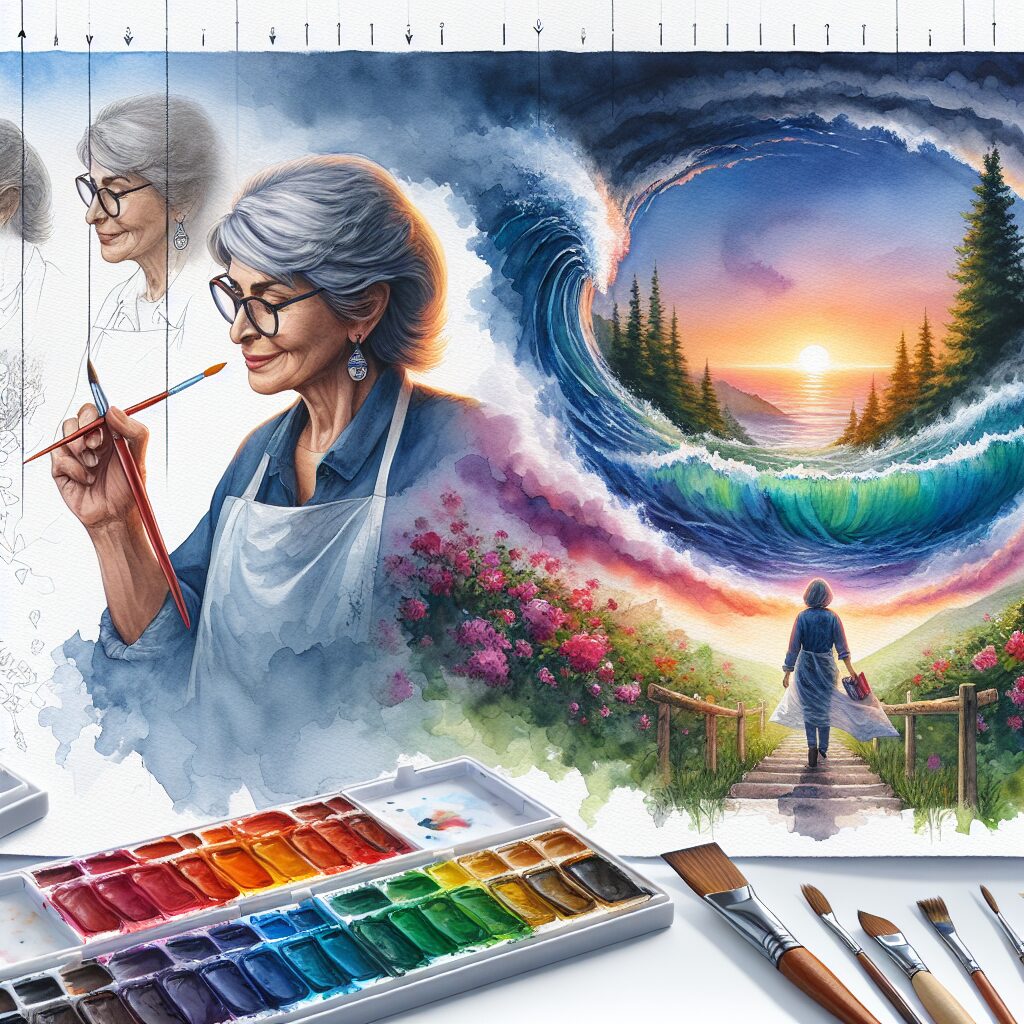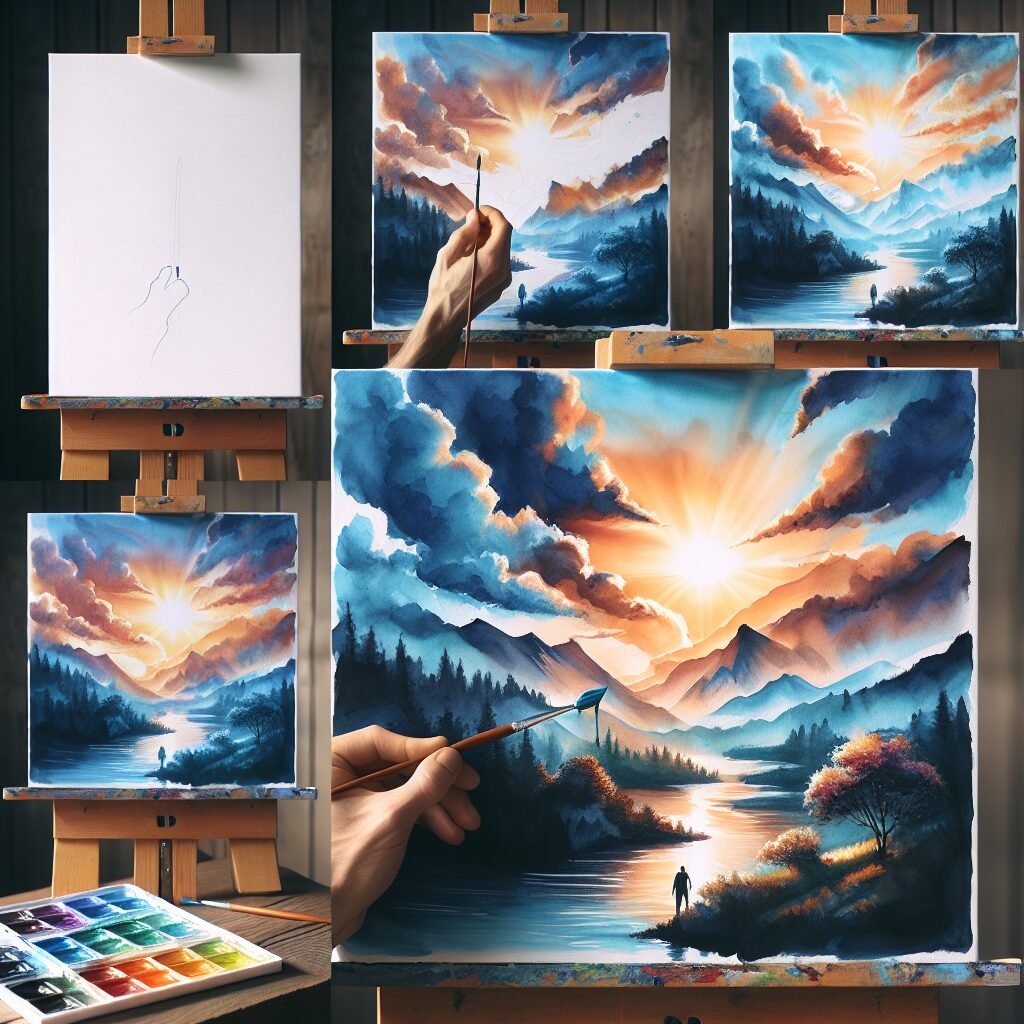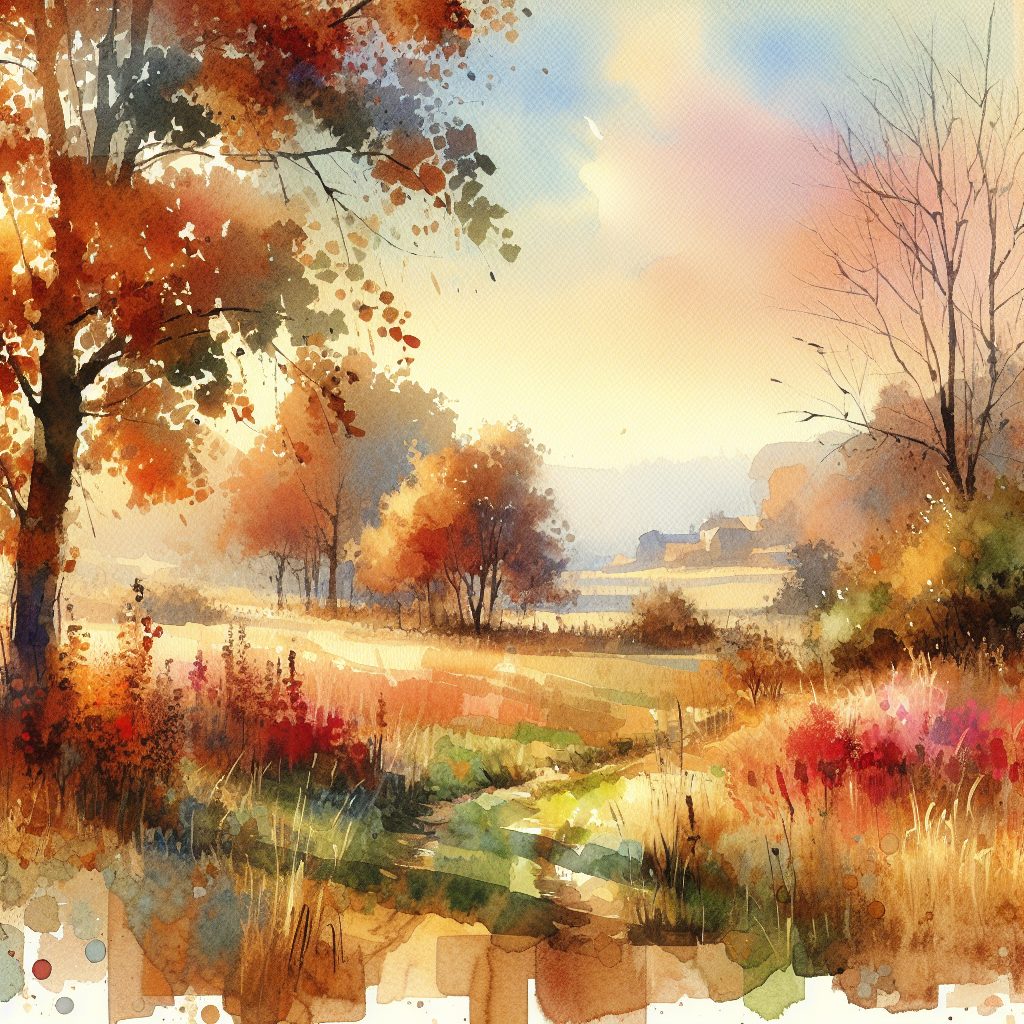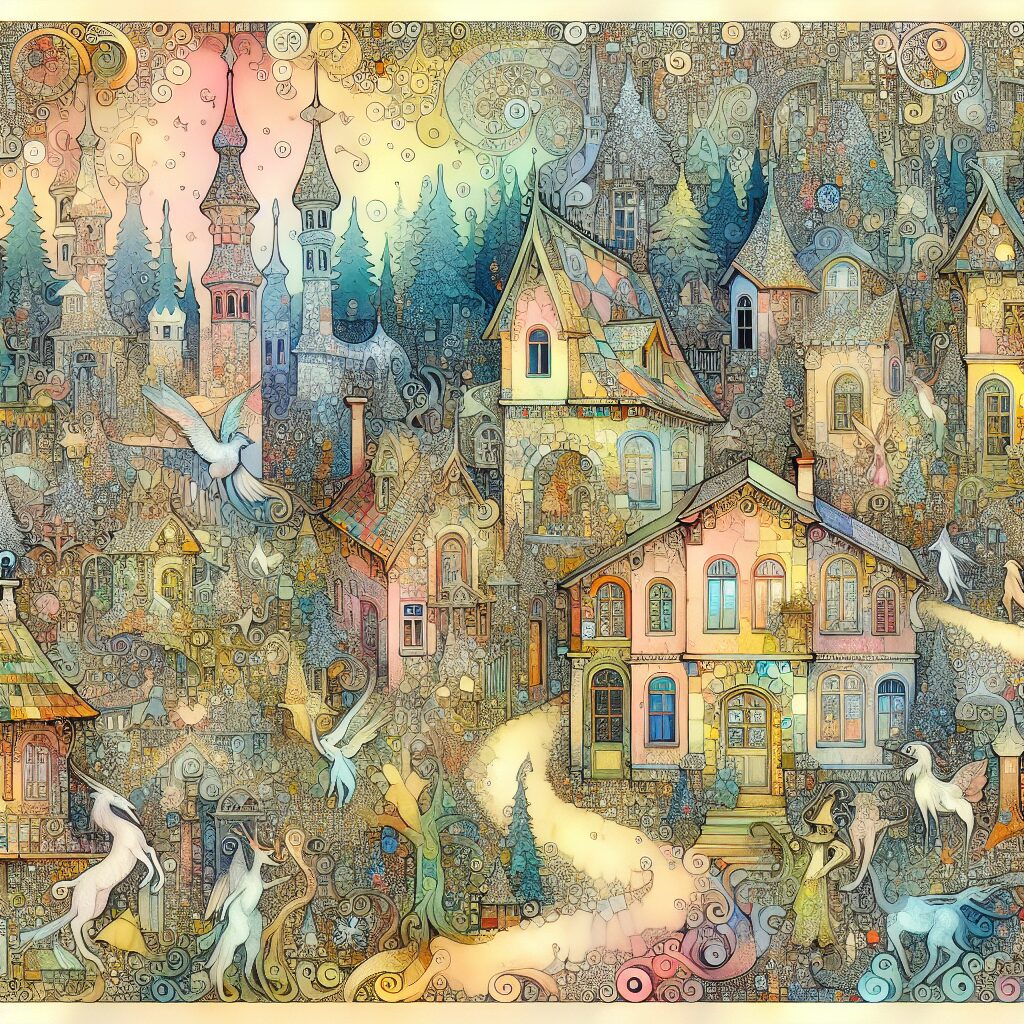
Table of Contents
- The Basics of Watercolor Painting: Techniques and Materials
- Exploring Color Theory in Watercolor Art
- Step-by-Step Guide to Creating a Watercolor Landscape
- Tips and Tricks for Achieving Depth and Texture in Watercolor
- Finding Inspiration: Exploring Different Subjects in Watercolor Art
- Watercolor Art as a Therapeutic Outlet: Benefits and Techniques
The Basics of Watercolor Painting: Techniques and Materials
Are you ready to dive into the world of watercolor painting? Whether you’re a beginner or an experienced artist looking to try something new, watercolor art is a beautiful and versatile medium that can bring your creativity to life. In this article, we’ll explore the basics of watercolor painting, including techniques and materials, to help you unleash your artistic potential.
Let’s start with the materials you’ll need to get started. The most essential item is, of course, watercolor paint. There are many brands and colors to choose from, so it’s a good idea to experiment and find the ones that suit your style. You’ll also need watercolor paper, which is specially designed to absorb and hold water without warping. Look for paper that is labeled as “cold-pressed” or “hot-pressed” for the best results.
In addition to paint and paper, you’ll need brushes. Watercolor brushes come in various shapes and sizes, each with its own unique purpose. A round brush is great for creating fine lines and details, while a flat brush is perfect for covering larger areas. Experiment with different brushes to see which ones you prefer.
Now that you have your materials ready, let’s dive into some basic watercolor techniques. One of the most fundamental techniques is called “wet-on-wet.” This involves wetting the paper with clean water before applying the paint. By doing this, the colors will blend and flow together, creating soft and ethereal effects. It’s a great technique for creating backgrounds or adding a sense of depth to your paintings.
Another technique to explore is “wet-on-dry.” This involves applying paint to dry paper, allowing for more control and precision. With this technique, you can create crisp lines and sharp details. It’s perfect for adding fine details to your artwork or creating intricate patterns.
As you experiment with different techniques, don’t be afraid to make mistakes. Watercolor painting is all about embracing the unpredictable nature of the medium. If something doesn’t turn out the way you envisioned, don’t worry! You can always let it dry and paint over it or incorporate it into your artwork in a different way. Remember, there are no mistakes in art, only opportunities for creativity.
Now that you have a basic understanding of watercolor techniques and materials, it’s time to let your creativity flow. Start by experimenting with different color combinations and brush strokes. Play with different levels of water and paint to create different effects. Don’t be afraid to try new things and push the boundaries of what you think is possible.
Remember, the journey of becoming a master watercolor artist takes time and practice. Don’t get discouraged if your first few attempts don’t turn out the way you hoped. Keep practicing, keep experimenting, and most importantly, keep having fun. Watercolor painting is a beautiful and rewarding art form that allows you to express yourself in unique and captivating ways.
So, grab your paintbrushes and let your imagination run wild. From blank canvas to masterpiece, watercolor art is waiting for you to unleash your creativity. Happy painting!
Exploring Color Theory in Watercolor Art
Hey there, fellow art enthusiasts! Are you ready to dive into the wonderful world of watercolor art? Well, grab your brushes and let’s get started! In this article, we’ll be exploring the fascinating realm of color theory in watercolor art. So, if you’re looking to unleash your creativity and create masterpieces on a blank canvas, this is the section for you!
Now, before we jump into the nitty-gritty of color theory, let’s take a moment to appreciate the unique qualities of watercolor as a medium. Unlike other forms of painting, watercolor has a translucent and ethereal quality that allows the colors to blend and flow effortlessly. It’s like capturing a moment in time with a delicate touch of a brush.
When it comes to color theory, understanding the basics is crucial. Colors have the power to evoke emotions, set moods, and tell stories. In watercolor art, the primary colors are red, blue, and yellow. These colors are the building blocks of all other colors on the color wheel. By mixing different combinations of these primary colors, you can create a vast array of secondary and tertiary colors.
Let’s start with the primary colors. Red is associated with passion, energy, and warmth. Blue, on the other hand, represents calmness, tranquility, and serenity. Lastly, yellow is often associated with happiness, joy, and optimism. By understanding the emotional impact of these colors, you can use them strategically in your artwork to convey specific messages or create certain atmospheres.
Now, let’s move on to secondary colors. Secondary colors are created by mixing two primary colors together. For example, mixing red and blue creates purple, blue and yellow create green, and yellow and red create orange. These colors offer a wider range of possibilities and can add depth and vibrancy to your artwork.
But we’re not done yet! Tertiary colors are created by mixing a primary color with a neighboring secondary color. This creates even more variations and shades. For instance, mixing red with purple creates a reddish-purple, while mixing blue with green creates a bluish-green. These tertiary colors can add subtle nuances and complexity to your artwork, making it visually captivating.
Now that we’ve covered the basics of color theory, it’s time to put your knowledge into practice. Experiment with different color combinations and see how they interact with each other on your canvas. Remember, watercolor is a forgiving medium, so don’t be afraid to make mistakes and explore new possibilities.
One technique that can help you understand color theory better is creating a color wheel. Start with a blank sheet of watercolor paper and draw a circle. Divide the circle into twelve equal sections, like a clock. Then, using your primary colors, paint each section with the corresponding color. As you move around the color wheel, mix the primary colors to create the secondary and tertiary colors. This exercise will not only help you understand color theory but also serve as a handy reference tool for future projects.
So, my fellow artists, embrace the world of color theory in watercolor art. Let your creativity flow and experiment with different combinations. Remember, there are no right or wrong answers when it comes to art. It’s all about expressing yourself and creating something that speaks to your soul. So, grab your brushes, mix those colors, and let your imagination run wild. Happy painting!
Step-by-Step Guide to Creating a Watercolor Landscape
Hey there, fellow art enthusiasts! Are you ready to dive into the wonderful world of watercolor art? Well, you’re in luck because today we’re going to take you on a step-by-step journey to creating a breathtaking watercolor landscape. So grab your brushes, squeeze out those vibrant colors, and let’s get started!
First things first, let’s talk about the importance of a blank canvas. Just like a painter needs a clean canvas to work on, you need to clear your mind and create a space for your creativity to flow. Take a deep breath, relax, and let your imagination run wild. Remember, there are no mistakes in art, only happy accidents!
Now that you’re in the right mindset, it’s time to gather your materials. You’ll need watercolor paper, brushes of various sizes, a palette, water, and of course, your favorite watercolor paints. Don’t be afraid to experiment with different brands and colors – this is your chance to unleash your artistic flair!
Once you have everything you need, it’s time to start sketching your landscape. You can use a pencil to lightly outline the main elements of your scene – whether it’s a majestic mountain range, a serene beach, or a charming countryside. Remember, this is just a rough sketch, so don’t worry about getting every detail perfect.
Now comes the fun part – adding color! Start by wetting your brush and dipping it into your chosen color. Watercolors are all about layering, so start with light washes and gradually build up the intensity. Don’t be afraid to mix colors on your palette to create unique shades that capture the essence of your landscape.
As you paint, remember to pay attention to the interplay between light and shadow. This is what brings depth and dimension to your artwork. Use lighter washes for areas that are hit by direct sunlight, and darker shades for areas in shadow. This contrast will make your landscape come alive!
Watercolor art is all about embracing the unpredictable nature of the medium. Don’t be afraid to let the paint do its own thing – allow it to blend and bleed, creating beautiful textures and patterns. This is what gives watercolor paintings their unique charm and ethereal quality.
Once you’re satisfied with the overall composition of your landscape, it’s time to add those final touches. This is where you can really let your creativity shine! Add details like trees, flowers, or even a little boat on a tranquil lake. These small elements can make a big difference in bringing your artwork to life.
And there you have it – your very own watercolor masterpiece! Step back and admire your creation. Remember, art is a journey, and each painting is a stepping stone towards mastering your craft. Don’t be discouraged if it doesn’t turn out exactly as you envisioned – embrace the process and learn from each stroke of your brush.
So go ahead, unleash your creativity with watercolor art. Let the colors flow, the brushes dance, and watch as your blank canvas transforms into a breathtaking masterpiece. Happy painting, my friends!
Tips and Tricks for Achieving Depth and Texture in Watercolor
Are you ready to take your watercolor art to the next level? If you’ve been dabbling in this beautiful medium and want to achieve depth and texture in your paintings, you’ve come to the right place. In this article, we’ll share some tips and tricks that will help you unleash your creativity and create masterpieces with watercolor.
One of the first things to keep in mind when working with watercolor is the importance of layering. Building up layers of paint can add depth and dimension to your artwork. Start with a light wash of color as your base layer, and then gradually add more layers, allowing each one to dry before adding the next. This technique will give your painting a sense of depth and make it more visually interesting.
Another way to achieve depth in your watercolor paintings is by using a variety of brush strokes. Experiment with different brush sizes and shapes to create different textures and effects. For example, using a small round brush for fine details and a larger flat brush for broad strokes can add interest and depth to your artwork. Don’t be afraid to play around and see what works best for you.
Adding texture to your watercolor paintings can also make them more visually appealing. One way to do this is by using salt. After applying a layer of wet paint, sprinkle some salt on top and let it dry. As the paint dries, the salt will absorb some of the pigment, creating a unique texture. You can also experiment with other materials like sponges, tissues, or even plastic wrap to create interesting textures and patterns.
When it comes to achieving depth and texture in watercolor, it’s important to remember that less is often more. Instead of trying to include every detail, focus on capturing the essence of your subject. Use your brush strokes and color choices to suggest texture and depth, rather than trying to replicate every little detail. This will give your artwork a more artistic and expressive feel.
One technique that can help you achieve depth and texture in your watercolor paintings is called glazing. Glazing involves applying thin layers of transparent paint over dry layers of paint. This technique allows you to build up color and create a sense of depth. Start with a light wash of color as your base layer, and then gradually add more layers of transparent paint, allowing each layer to dry before adding the next. This will give your painting a luminous quality and make it more visually interesting.
Finally, don’t be afraid to experiment and have fun with your watercolor art. Watercolor is a versatile medium that allows for a lot of creativity and spontaneity. Don’t worry about making mistakes – embrace them and learn from them. The more you practice and explore different techniques, the more you’ll grow as an artist and develop your own unique style.
So, grab your watercolor paints and brushes, and start unleashing your creativity. Remember to layer your paint, experiment with brush strokes, add texture, and embrace the beauty of imperfections. With these tips and tricks, you’ll be well on your way to creating stunning watercolor masterpieces that are full of depth and texture. Happy painting!
Finding Inspiration: Exploring Different Subjects in Watercolor Art
Are you ready to dive into the world of watercolor art? Whether you’re a beginner or an experienced artist, watercolor is a versatile and exciting medium that allows you to unleash your creativity and create stunning masterpieces. One of the first steps in creating a watercolor masterpiece is finding inspiration. In this article, we’ll explore different subjects that you can explore in your watercolor art.
Nature is a timeless source of inspiration for artists, and watercolor is no exception. The delicate and translucent nature of watercolor paints lends itself perfectly to capturing the beauty of flowers, trees, and landscapes. Take a walk in the park or your own backyard and observe the colors, shapes, and textures of the natural world. You can then translate these observations onto your watercolor paper, using washes and layers to create depth and dimension.
If you’re looking for a more urban vibe, cityscapes and architecture can be a fascinating subject for watercolor art. The interplay of light and shadow on buildings, the intricate details of bridges and landmarks, and the hustle and bustle of city life can all be captured with the fluidity of watercolor. Experiment with different techniques, such as wet-on-wet or dry brush, to create the desired effects and bring your cityscape to life.
Animals and wildlife are another popular subject in watercolor art. From majestic lions to delicate butterflies, the animal kingdom offers a wide range of possibilities for your watercolor creations. Pay attention to the unique characteristics of each animal, such as fur, feathers, or scales, and use your brushstrokes to capture their essence. Don’t be afraid to experiment with different colors and textures to add depth and personality to your animal portraits.
Still life paintings are a classic subject in art, and watercolor can add a fresh and vibrant twist to this genre. Arrange objects such as fruits, flowers, or everyday objects on a table or a windowsill, and use your watercolor skills to capture their beauty. Play with composition, lighting, and color to create a visually appealing and dynamic still life painting. Remember to observe the interplay of light and shadow on your objects and use different brushstrokes to create texture and depth.
Finally, don’t forget about the human figure as a subject for your watercolor art. Portraits and figures can be challenging but rewarding subjects to explore. Capture the emotions, expressions, and unique features of your subjects with the fluidity and transparency of watercolor. Experiment with different techniques, such as glazing or lifting, to create the desired effects and bring your portraits to life.
In conclusion, finding inspiration is an essential step in unleashing your creativity with watercolor art. Whether you choose to explore nature, cityscapes, animals, still life, or the human figure, each subject offers its own unique challenges and rewards. Remember to observe, experiment, and have fun with your watercolor journey. With practice and dedication, you’ll be able to transform a blank canvas into a masterpiece that reflects your artistic vision. So grab your brushes, mix your paints, and let your creativity flow with watercolor art.
Watercolor Art as a Therapeutic Outlet: Benefits and Techniques
Are you looking for a new way to express your creativity? Have you ever considered trying watercolor art? Watercolor painting is not only a beautiful form of artistic expression, but it can also be a therapeutic outlet for stress relief and self-discovery. In this article, we will explore the benefits of watercolor art as a therapeutic activity and discuss some techniques to help you unleash your creativity.
One of the greatest benefits of watercolor art is its ability to provide a sense of relaxation and stress relief. The process of mixing colors, applying brushstrokes, and watching the paint flow on the paper can be incredibly calming. It allows you to focus on the present moment and let go of any worries or anxieties. The gentle and fluid nature of watercolor painting can create a meditative state, helping you to find inner peace and tranquility.
Watercolor art also offers a unique opportunity for self-expression and self-discovery. As you experiment with different techniques and explore various subjects, you can uncover hidden emotions and thoughts. The colors you choose, the brushstrokes you make, and the composition you create all reflect your personal style and perspective. Through watercolor art, you can tap into your subconscious and gain a deeper understanding of yourself.
To get started with watercolor art, you don’t need a lot of expensive materials. All you need is a set of watercolor paints, brushes, watercolor paper, and a container of water. You can find these supplies at your local art supply store or online. Once you have your materials, find a quiet and comfortable space where you can set up your art station. It could be a corner of your living room, a dedicated art studio, or even your kitchen table.
Before you begin painting, it’s helpful to familiarize yourself with some basic watercolor techniques. One technique is called wet-on-wet, where you wet the paper with clean water before applying the paint. This technique creates soft and blended colors. Another technique is wet-on-dry, where you apply the paint onto dry paper. This technique allows for more control and crisp edges. Experimenting with these techniques will help you discover your preferred style and create different effects in your artwork.
As you start painting, remember that there are no right or wrong ways to create art. Embrace the imperfections and let go of any self-judgment. Allow yourself to make mistakes and learn from them. Watercolor art is all about embracing the unexpected and going with the flow. Don’t be afraid to take risks and try new things. The more you practice, the more confident you will become in your abilities.
In conclusion, watercolor art is not only a beautiful form of artistic expression but also a therapeutic outlet for stress relief and self-discovery. Through the process of mixing colors, applying brushstrokes, and watching the paint flow on the paper, you can find relaxation and inner peace. Watercolor art allows you to tap into your subconscious and express your unique perspective. With some basic techniques and a willingness to experiment, you can unleash your creativity and create masterpieces on a blank canvas. So why not give watercolor art a try? You might just discover a new passion and a whole new world of artistic possibilities.


